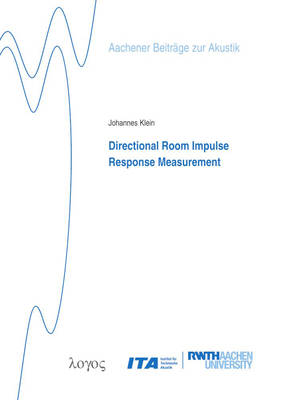
Je cadeautjes zeker op tijd in huis hebben voor de feestdagen? Kom langs in onze winkels en vind het perfecte geschenk!
- Afhalen na 1 uur in een winkel met voorraad
- Gratis thuislevering in België vanaf € 30
- Ruim aanbod met 7 miljoen producten
Je cadeautjes zeker op tijd in huis hebben voor de feestdagen? Kom langs in onze winkels en vind het perfecte geschenk!
- Afhalen na 1 uur in een winkel met voorraad
- Gratis thuislevering in België vanaf € 30
- Ruim aanbod met 7 miljoen producten
Zoeken
€ 105,45
+ 210 punten
Omschrijving
Measured room impulse responses are inextricably linked with the distinct directivity patterns of the applied sources and receivers. In room acoustic measurements, the directivity is often disregarded or intentionally smoothed, waiving detailed information about single reflection paths, also denying the possibility of analyzing and auralizing the acoustic scene in relation to specific real-world sources and receivers. The measurement of directional room impulse responses as a set of measurements with unique directivity patterns can compensate for these shortcomings, retaining the information about the acoustic properties of a room in connection with directional information. Ideally, a directional room impulse response measurement consists of a single session and allows for the flexibility of choosing the desired directivity patterns in post-processing by combining different impulse response sub-sets. Such a procedure requires specialized measurement arrays. The lack of knowledge about the required level of directional detail, physical constraints of the array construction, and expected measurement artifacts hinder and feed-back into the development of the instruments and methods. This thesis explores these requirements and limits, focusing primarily on the design of suitable sources allowing for directional room impulse response measurement procedures with variable directivity.
Specificaties
Betrokkenen
- Auteur(s):
- Uitgeverij:
Inhoud
- Aantal bladzijden:
- 240
- Taal:
- Engels
Eigenschappen
- Productcode (EAN):
- 9783832551391
- Verschijningsdatum:
- 28/07/2020
- Uitvoering:
- Paperback
- Formaat:
- Trade paperback (VS)
- Afmetingen:
- 145 mm x 211 mm
- Gewicht:
- 508 g

Alleen bij Standaard Boekhandel
+ 210 punten op je klantenkaart van Standaard Boekhandel
Beoordelingen
We publiceren alleen reviews die voldoen aan de voorwaarden voor reviews. Bekijk onze voorwaarden voor reviews.









